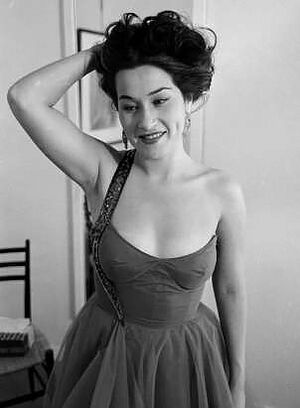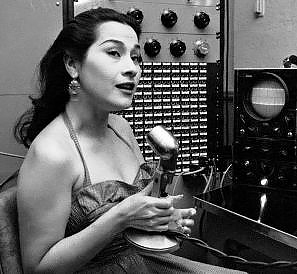Kaida Rakodi
Kaida Rakodi | |
|---|---|
 Kaida Rakodi in 1969 | |
| Background information | |
| Also known as |
|
| Born | 10 September 1938 Releş, Xevden |
| Genres | |
| Instruments | Vocals |
| Years active | 1957–2008 |
Kaida Rakodi (born 10 September 1938) is a retired Gylian coloratura soprano. She achieved wide renown for her voice, which had an extraordinarily wide range that reached 5 octaves at the height of her career, and an acclaimed bright timbre.
Her vocal talent was discovered early in life, and her difficult childhood gave her a compulsion to sing that would mark her career. She received voice lessons in the Free Territories and made her debut on radio at the age of 19, after which her career developed rapidly.
Celebrated as Gylias' most successful operatic and classical singer, Kaida sang a wide repertory of works that encompassed opera, classical, and popular music both historical and contemporary, with an emphasis on the works of Gylian composers.
She performed and recorded prolifically, driven by a preoccupation with preserving and documenting her vocal talent as much as possible. She often sang unaccompanied, and made full use of the recording studio's possibilities for overdubbing and vocal harmonies. She was a regular presence on the GNBS and a popular media personality.
While Kaida achieved international renown, she performed comparatively fewer concerts abroad, and did not enjoy these experiences. She focused her career on Gylias, where she felt more comfortable. She was known for her efforts to minimise spectacle and remain accessible, performing in Levystile clothing and with a minimum of on-stage movement.
She retired from singing in 2008, giving her last public performance on her 70th birthday. She is considered a cultural icon in her native Gylias, where she was dubbed the "Gylian Songbird" and the "People's Songbird".
Early life
Kaida Rakodi was born in Releş on 10 September 1938. Her parents were of mostly Gylic and some Hayeren descent. The family was poor, and her parents' marriage was tense due to differences in education and personality.
She had a difficult upbringing. Her mother was at times demanding and had "old-fashioned" ideas about social graces, giving her daughter an education reminiscent of a charm school. Her father strongly emphasised self-reliance and discipline as a way for her to escape her poor background.
Kaida was a rebellious child and found both of her parents overbearing at times, sometimes doing as instructed reluctantly and passive-aggressively. Her relationship with her parents improved due to her musical career, which made her an extremely disciplined neat freak.
During her childhood, the Liberation War struck her hometown twice — first captured by the People's Army, then besieged by the Xevdenite army in 1948. She was educated in volunteer classes in the Free Territories. She was known to other children for her refined bearing, which influenced her personality further in that direction.
She began singing at a young age, and her vocal talent was discovered when she was 12. She was personally taught by Lisa Paglin and Marianna Brilla, the founders of the Brilla-Paglin vocal school, who adopted her as their "star pupil". She adopted a lifestyle of total immersion in her musical education, which she would largely maintain as a professional musician
The experience of war in childhood caused Kaida some trauma. As an adult, this manifested in an obsession with working as much as possible, and a resigned awareness that her talent was not permanent. "My voice is a national treasure," she declared in 1967, "so it belongs to the people. The people must have all of it." At other times, she compared her voice to the demurrage-based currencies of the Free Territories and Gylias: both would lose their value over time.
Career
Kaida's first public performance was during a radio broadcast in 1957. The same year, she married Niciné Rarþys, a pianist and composer who became her lifelong collaborator and arranger. She made her operatic debut aged 21, playing Lisinga in an informal performance of Rossini's Demetrius and Polybius.
From there, her fame quickly spread. She developed a schedule of 3-4 concerts per week with some time off, satisfying her desire to work while preserving her voice. She performed throughout Gylias, with various instrumental backings from symphonic orchestras to small combos or merely her husband's piano, and in a variety of settings. She and her husband were licensed street performers, and delighted in surprising passers-by with unexpected performances in public and on public transport.
Kaida became a regular presence on GNBS, and enjoyed the staunch support of its director Eija Nylund, who once said, "Kaida can appear whenever she wants, wherever she wants, doing whatever she wants." She performed monthly concerts of classical and modern music on Gylian Radio and Gylian Television, modeled after the Young People's Concerts, and was known to generations as "the Golden Voice of Gynbris".
Recordings
Kaida was just as prolific in the studio, and appreciated the simpler recording process. She made in excess of 10.000 studio recordings throughout her career. She worked with orchestras, string sections, small ensembles, conventional pop and rock bands, experimental groups, and by herself.
She was finely attuned to the possibilities of the recording studio as an instrument, and made full use of them. She would record multiple takes and edit them together to achieve the perfect performance, and overdub her own harmonies, sometimes to the point of being a one-woman mass singing ensemble.
One of her most celebrated recordings was made in 1962: a striking, all-vocal rendition of the national anthem. Praised by music journalists for capturing both the desolate melancholy of the anthem's origins and the celebratory optimism of the Golden Revolution, it became a commonly-used theme on GNBS, and was closely associated with her.
Kaida often gave the impression of being "bewildered and a little intimidated" by her voice, treating herself as merely its "vessel". This attitude emerged in the studio, as she agreed to several "scientific experiment" sessions, which she sang while having her vocal cords photographed or measured through a spectrometer and similar instruments.
Between 1963 and 1973, she recorded a series of yearly sessions for Gylmuse, singing all the notes of her range for a fixed period of time. She wished to allow people in the future to play her voice on a keyboard — a far-sighted goal when the Chamberlin and Mellotron were only coming into use. These recordings were later used and looped to create patches for digital synthesiser-samplers, including the Fairlight CMI and Synclavier. She called this one of her proudest achievements.
Collaborations
Kaida worked with numerous Gylian musicians throughout her career. She joked in an interview, "I want to be the first person people call when they want a bit of opera or class on a track, and also the last."
One of her best-known collaborations was with The Beaties: she sang the massed backing vocals of The White Album's closing track, "Good Night". One of her vocal performances was also sampled in the preceding track, "Revolution 9".
She also made several collaborative recordings with Hilda Wechsler. The two were close friends and mutually admired each other's work ethic and ambition.
Kaida often expressed her ambition to be the summit of Gylian music — to "contain all Gylian music in her coat". While she was able to become the accepted authority on Gylian art music, she never enjoyed the same dominance in the field of popular music. Nevertheless, she was widely respected and admired, and called on the services of many famous musicians and songwriters, who held her in high regard.
Repertoire
Possessed of a good memory and a quick study with a song, Kaida sang a wide variety of music throughout her career. She performed opera and classical music, art music and light music, folk music and various genres of popular music and experimental music. Her openness and eclecticism endeared her to the Gylian public, but caused frictions with foreign classical performers, whom she described as "quite class-bound and looking down their nose at pop."
Her classical repertoire was shaped by her Brilla-Paglin vocal training. She preferred performing music of the 18th and 19th centuries, and some romantic music. She disliked Giuseppe Verdi and Giacomo Puccini, absorbing her teachers' message that they had caused a destructive shift towards more extreme singing in opera, and despised Richard Wagner, referring to his work as "the pathetic ejaculates of a play-acting Futurist." She also firmly refused to sing any religious music or music with specifically christian overtones.
Since her repertoire excluded religiously-inclined music or the emotionally-charged operatic tendencies of the 19th century, she instead was notably open to performing contemporary classical music and experimental music.
Kaida sang songs in many languages. When recording these in the studio, she would have a dialect coach with her to perfect her pronunciation. When learning these songs, she would have their lyrics written out in Gylic transcription to understand the intended pronunciation.
She preferred to sing soprano leggero roles as her usual.
Vocal style
Kaida was classified as a coloratura soprano or soprano sfogato. She had a bright and sweet vocal timbre, capable of great clarity and excellent diction when singing. Despite her fears, age did not affect her voice significantly, and she retained much of her vocal power on retirement. She credited her vocal teachers for her longevity, particularly their emphasis on proper breathing technique and avoiding vocal over-exertion.
She had one of the widest vocal ranges of a singer, measuring 5 octaves and possibly a few notes above. Her lowest sung note was a C1; her highest was a D8. At the extreme high end of her range, she was noted for her ability to imitate the trill of birds. She was distinguished for her agile runs, leaps and trills while singing.
Her voice was widely acclaimed. The writer Anaïs Nin wrote in her Diary:
"The voice has all the richness, beauty, and range of a mythical woman. It does not seem humanly credible. She sings like a siren, a bird, a spirit, some seductive chant never heard before, high and low, fragile and strong. With all that, she has the exotic beauty of a legendary figure."
Performance
Kaida considered herself a singer, not an actor. Following the more casual Gylian approach to art music, she performed on stage as if at a standard concert, facing the audience directly.
She had a minimalistic and relaxed stage presence. She smiled while singing, kept her hands clasped behind or in front of her, and never showed any obvious signs of effort, which impressed audiences.
She famously began her shows by waiting for applause to end, approaching the microphone, raising her finger to her lips, and saying, "Shhh. Quiet please, this is an opera."
Reputation
Kaida maintained a down-to-earth image. She wore Levystile suits while perfoming and recording. Her restricted wardrobe defined her public image, and earned her the nickname "the georgette of the stage". She used cosmetics to enhance her exotic looks, and often used Gauchic portraits of herself for album covers.
She strongly associated wearing the right clothing with achieving complete concentration and control of her talent, and thus maintained a fastidious, buttoned-up appearance while singing. At times, she would even cover up as much of her body as possible out of a belief it would focus her energy — wearing scarves, gloves, and ankle-length skirts.
Described by her husband as "self-sacrificing to a fault", she took any opportunity she had to sing, and would on many occasions decline payment, treating her contribution as a gift.
Kaida led a modest and regimented lifestyle. She awoke every morning at 6:00, ate at exact hours, and went to bed at 23:00. She lived in a small but comfortable apartment with her family. She performed vocal exercises for two hours every day, and would practice both vocal warm ups and "warm downs" before and after a concert or recording session.
She led a "fanatically teetotal" lifestyle: she abstained from alcohol, tobacco, or drugs, and followed a mostly vegetarian diet. She kept in shape by cycling and jogging, and enjoyed socialising with others.
Most of those who encountered her recalled they were most impressed that, despite leading what sounded like a severe and ascetic lifestyle, she was "supremely relaxed in everything she did", and had a friendly and playful personality, fond of silly humour and jokes.
She was affectionate and protecting towards her younger collaborators, friends, and fans, and would fondly address them as "children".
She was depicted in Lia Fyresi's 1974 documentary Our Songbird, which captured her "grace under pressure" on film. Its most famous scene depicts Kaida in close-up, in a dark room, under hot studio lights, wearing slightly too tight clothing and heavy makeup, and calmly performing some of the most challenging arias of her repertoire.
Kaida had fun collaborating with comedians, usually appearing in sketches that portrayed her wasting her talents in highly prosaic contexts. She appeared in one of Annemarie Beaulieu's Hysterical Art short films, being filmed singing an operatic passage while being brought to orgasm by a vibrator.
Political involvement

Kaida developed a close relationship with Eiín Dairyn, the first President of Gylias. Eiín invited her to perform in honour of her inauguration, and the two became friends. Kaida appreciated Eiín's strong commitment to promoting Gylian culture and the arts, and would give several private performances at her request, including to celebrate her presidential election victories.
She had similarly good relationships with several members of the Darnan Cyras government, including education ministers Rin Tōsaka and Sakura Tōsaka, Arts Council chair Tomoko Tōsaka, and culture minister Eoni Nalion.
She was a high-profile supporter of the Progressive Alliance, campaigning for them during the 1962 and 1969 federal elections. She performed at The New World's Fête d'Nouvelle Monde festival for many years.
Kaida and her mentors Marianna Brilla and Lisa Paglin supported an initiative to set orchestras' pitch standards by law, in order to reduce pitch and thus strain on singers' voices. The initiative was approved in a referendum in 1967.
Later career and retirement
Kaida maintained an active recording and performance schedule into her late career, but began slowing down her pace in the 1990s. The development of the internet in Gylias represented an opportunity for her to secure her legacy: she oversaw the remastering of her audio and video recordings for Proton and NetStream.
Choosing to retire, she gave her last public performance on 10 September 2008, her 70th birthday. Aterwards, she decided to live quietly in retirement with her family. She has made few public appearances since, and declined offers to be a voice coach, explaining, "I have no aptitude for teaching, sadly."
Legacy
Kaida is one of Gylias' most acclaimed vocalists, and successful performers of opera and classical music. Her openness towards popular and modern music made her a pioneer of operatic pop, while her profuse generosity and dedication to her craft made her a cultural icon. Her all-vocal recordings have been influential on numerous artists, for her massed harmonies and use of vocals and processing to emulate instruments.
Based on the precedent set by the Fairlight and Synclavier, the majority of Gylian-made synthesizers since the 1980s have patches for female voice and female ensemble using her voice.
Her static stage presence was jokingly cited as an inspiration by shoegazing musicians.
Our Songbird was an unexpected influence on Gylian pornography, inspiring pornographic directors to explore the sexual potential of the kind of unflappable, buttoned-up characters similar to Kaida's stage presence.
Private life
Kaida married Niciné Rarþys in 1957. She once stated, "In our case, it turned out for the best that we married young. We were amazingly lucky." The couple have a child, Kumy, born in 1964.
She is a practitioner of Concordian and Hellenic polytheism, and is a vocal opponent of organised religion.

